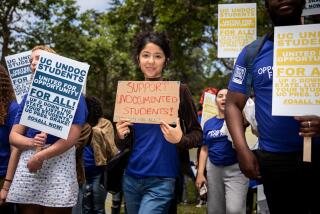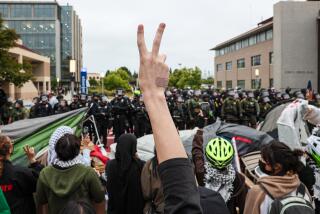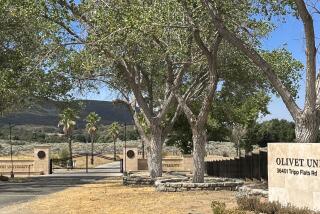Pomona College protest’s party atmosphere belies strife
The protest at Pomona College on Friday was much like a big outdoor celebration. Tables were set in the middle of the street, a mariachi played, and electrical and grocery union workers served carne asada. But beneath it simmered a dispute between dining hall workers and the administration that has placed the small liberal arts college on the map of the nation’s battles over labor and immigration policy.
The quarrel over a unionization effort, which had endured for two years, took a dramatic turn in December when the school fired 17 immigrant workers because they could not provide proper paperwork.
The firings galvanized workers, many students and some faculty. Months later, the unrest continues. For several weeks, some students set up tents in front of the campus in protest. Others blocked an intersection and were arrested. They have demanded that the workers be reinstated and that the school accept a neutrality agreement with union organizers.
The college of about 1,500 students is a tight-knit one. Almost all students live on campus and eat in the dining halls multiple times a day. Cooks and dishwashers get to know students over the years, said former dishwasher Juan Gonzalez. He worked at the college for 10 years before he was fired, he said. Unable to find a new job, he dedicates a lot of his time to organizing against the administration with the help of students he knew as an employee.
“The indignation that the students showed gave us strength to keep going,” he said in Spanish.
Since the firings there have been vigils, theater performances, meetings with the school president and other actions, he said.
Administration officials say they launched an audit after someone complained to the chairman of the board of trustees that the school failed to check work authorization documents as required by law. Although it did not support the broad allegations, the audit turned up more than 80 workers whose paperwork was missing or incomplete.
The school gave workers a few weeks to submit corrected documents. Seventeen were unable to do so, said school spokeswoman Cynthia Peters. Sixteen of them were dining hall workers.
“There are very many on campus, including the administration, who wish there had been an option to retain the employees,” Peters said.
The timing of the audit, however, has drawn suspicion and sparked a growing campus divide.
The protest Friday, organized around Saturday’s commemoration of labor activist Cesar Chavez, was billed as an effort to restore calm to the campus. Union activists, workers, day laborers and several students carried posters with neon-colored peace signs.
But the firings have made workers more unwavering in their demand that the administration agree not to interfere with the unionization efforts. Such an agreement would remove what Rolando Araiza, 22, a dining hall cook, called an atmosphere of coercion.
“After everything that happened, they broke the trust,” he said. “It’s time for them to step aside and let the workers decide what they want.”
Administration officials said such an agreement is tantamount to a gag order that would keep them from arguing their side of the issue.
Despite the disagreements, Araiza said, “I’m very proud to be working for a school like this.”
Watching students come in as freshmen, graduate and go on to their professional lives “showed me what was possible,” he said. “They showed me that we could have a voice.”
More to Read
Sign up for Essential California
The most important California stories and recommendations in your inbox every morning.
You may occasionally receive promotional content from the Los Angeles Times.










